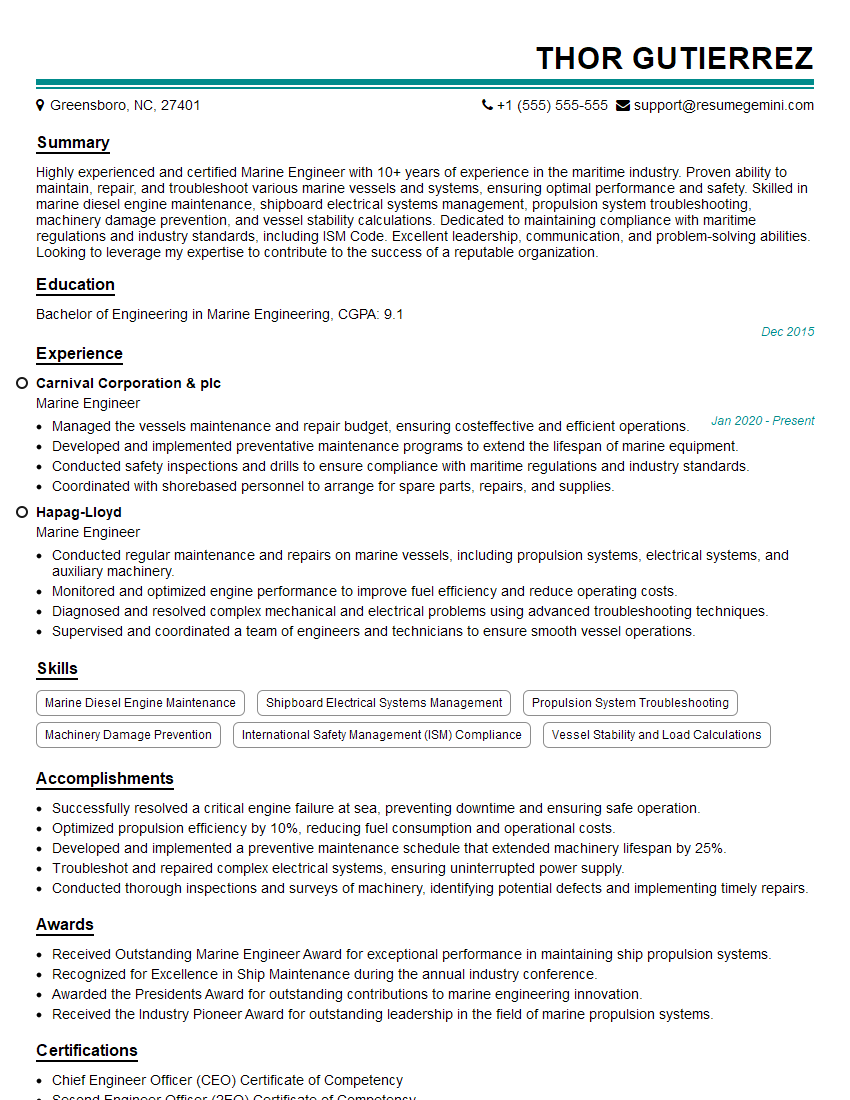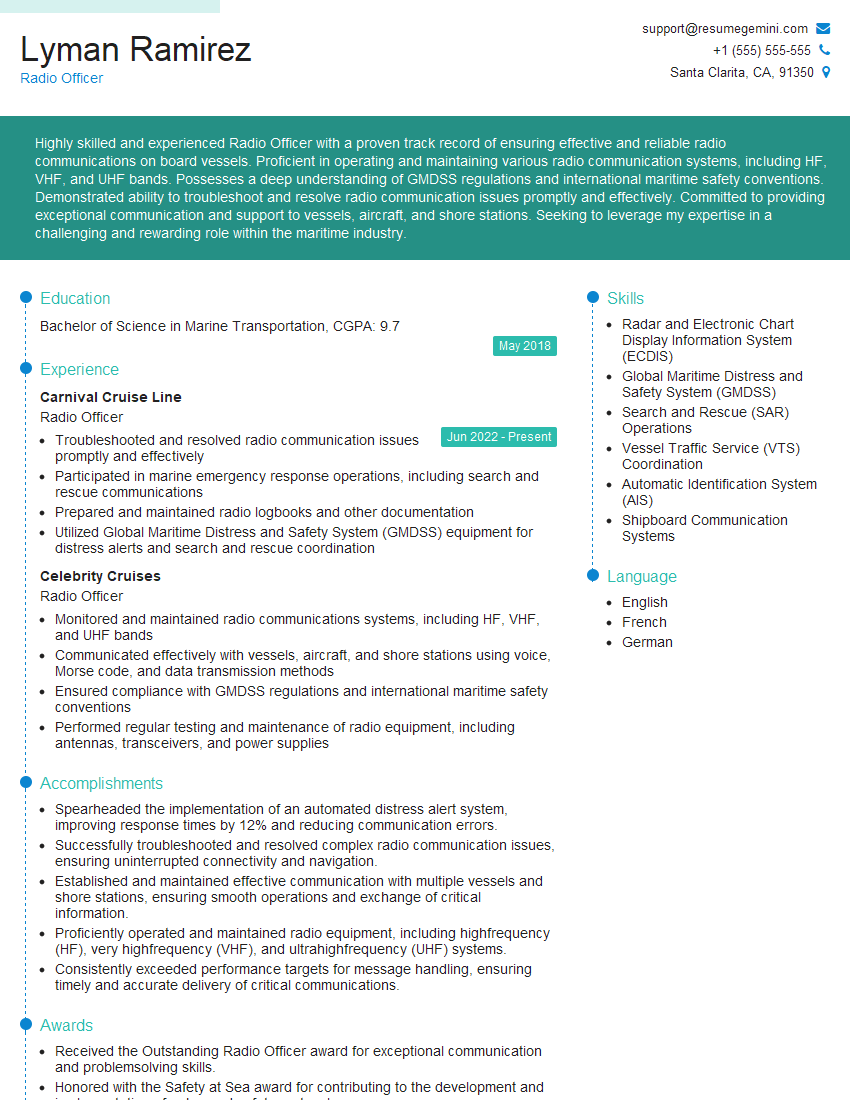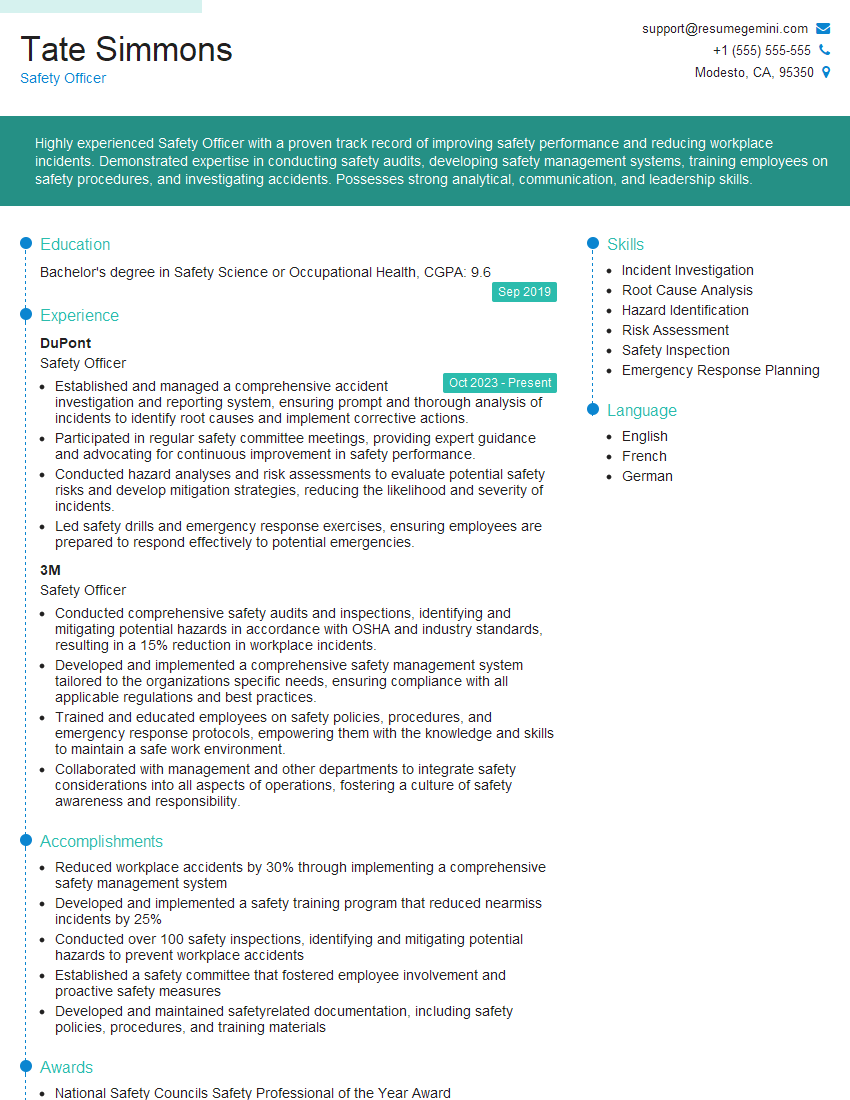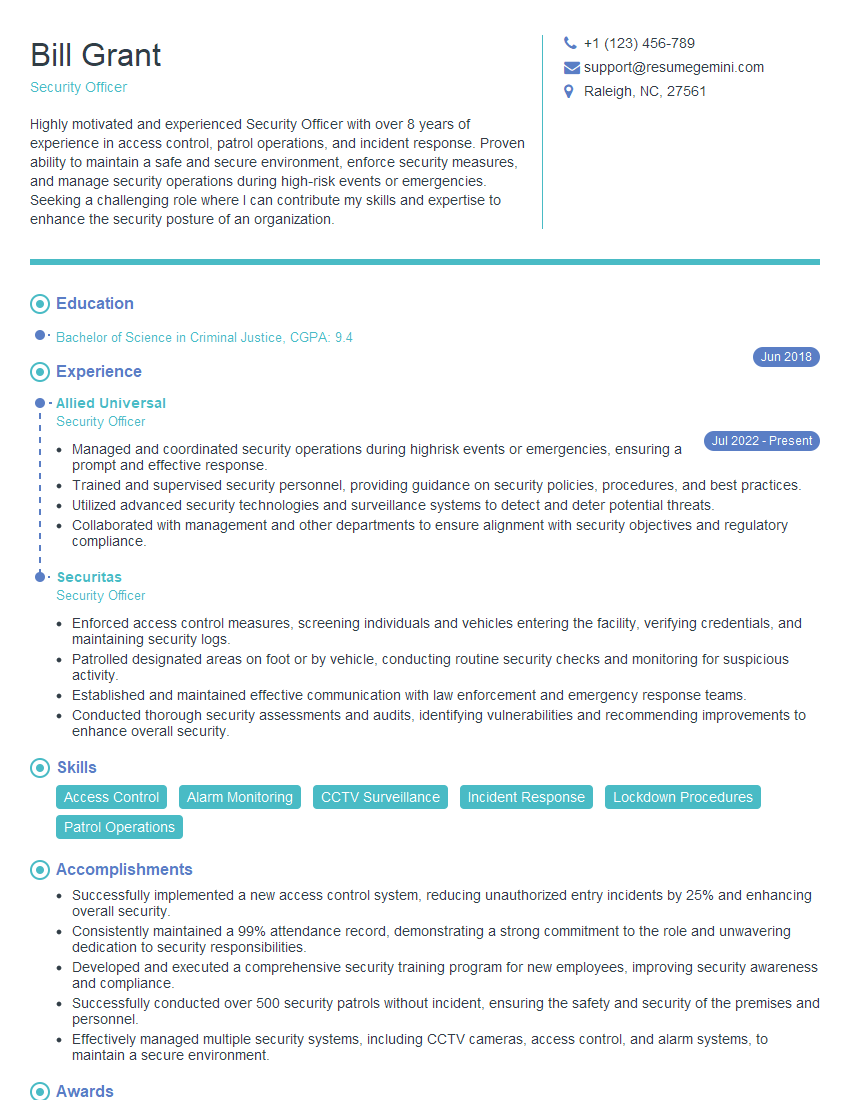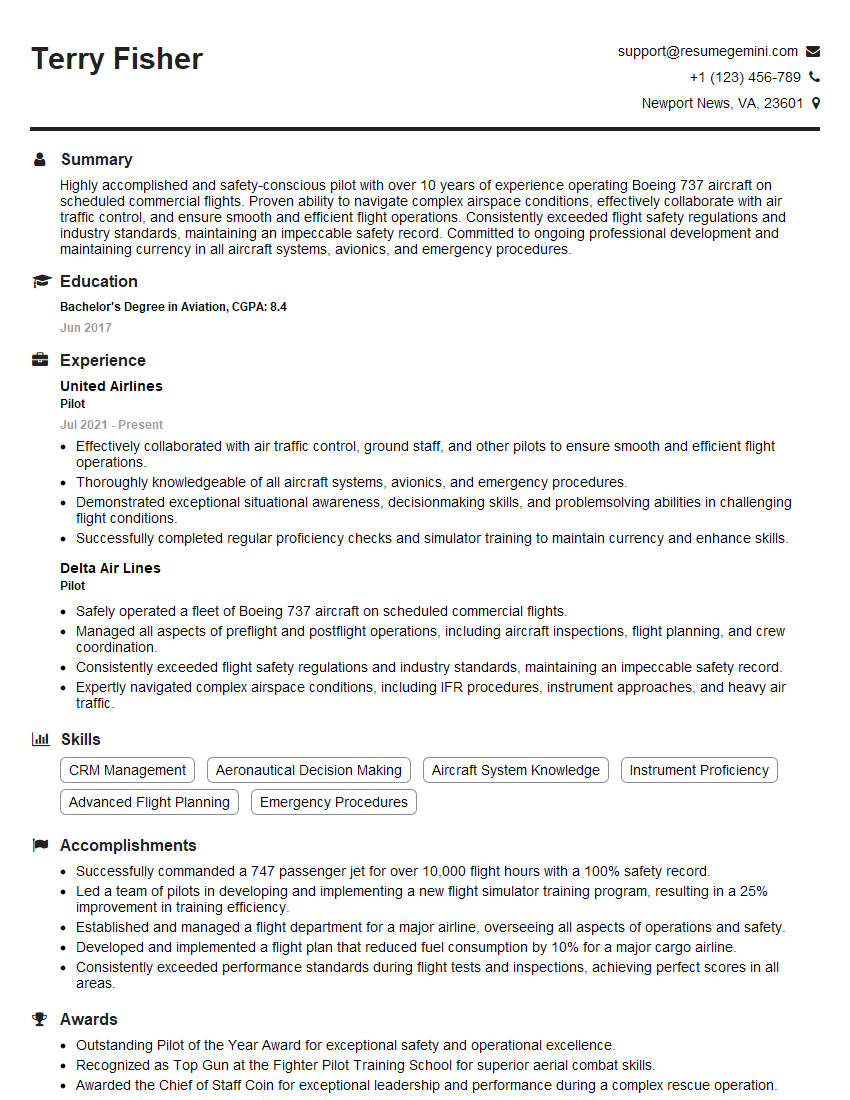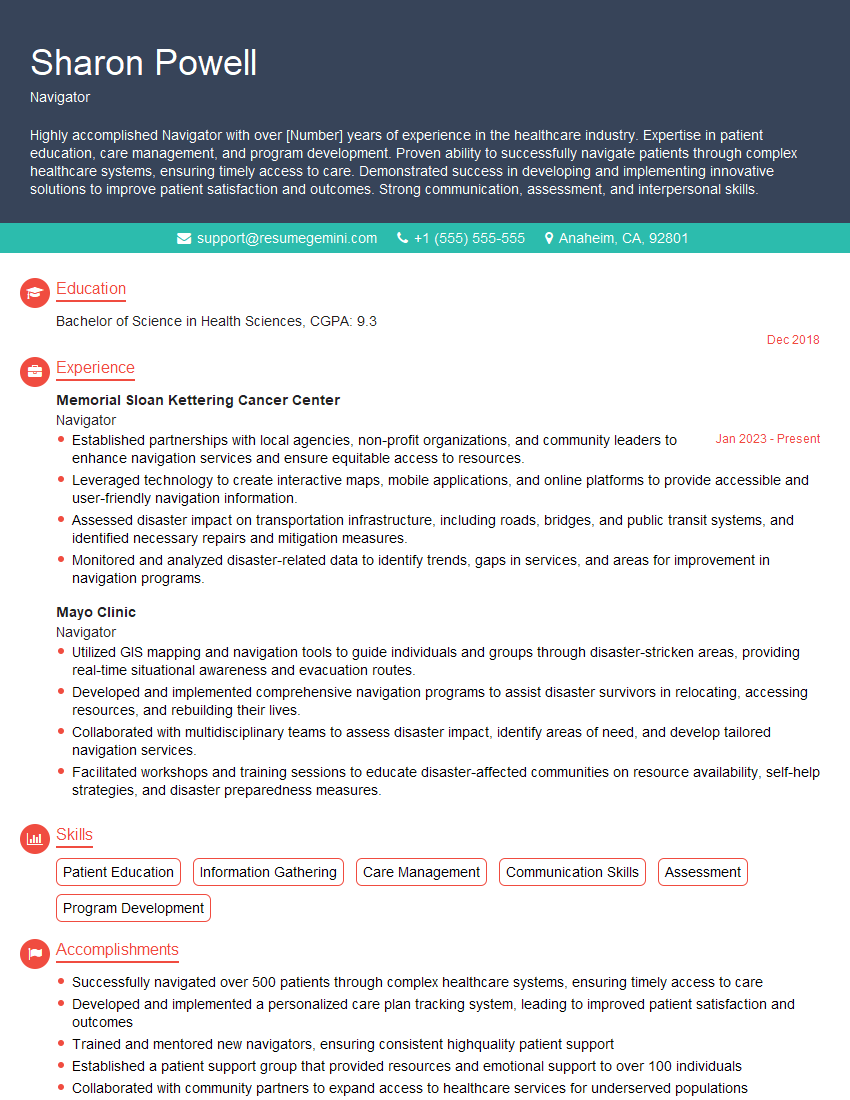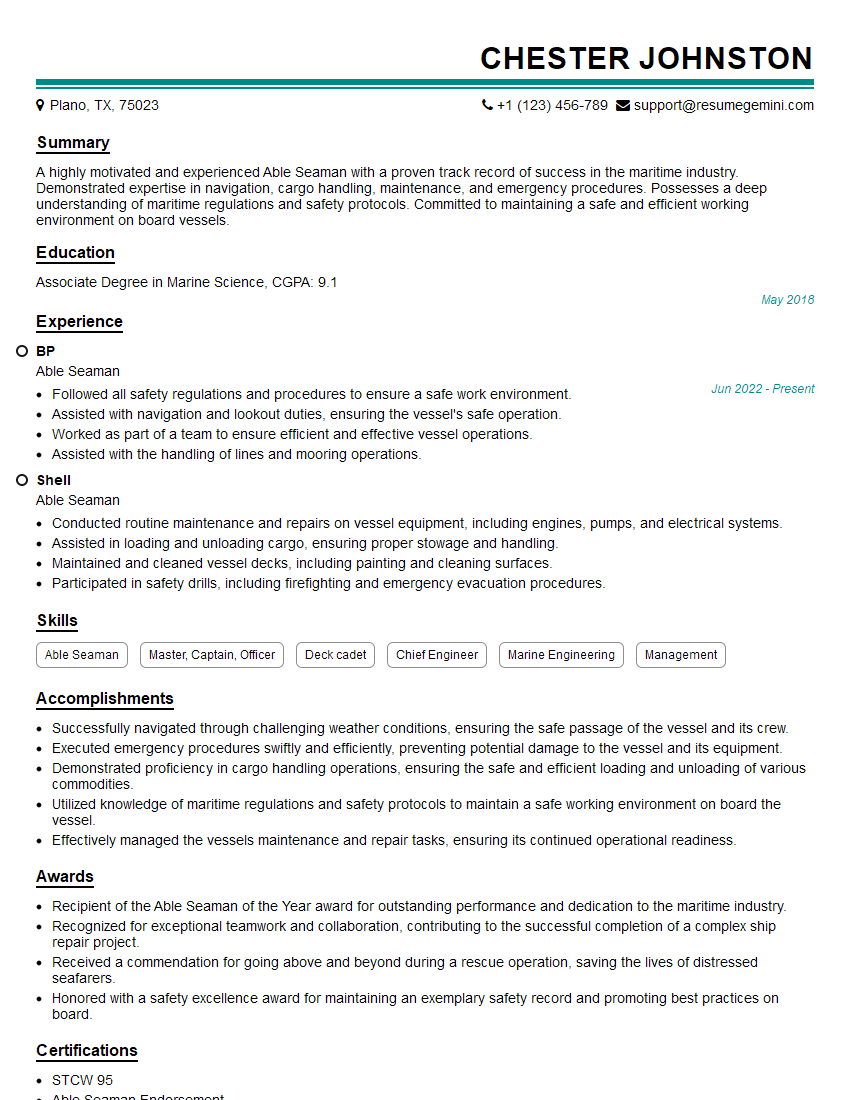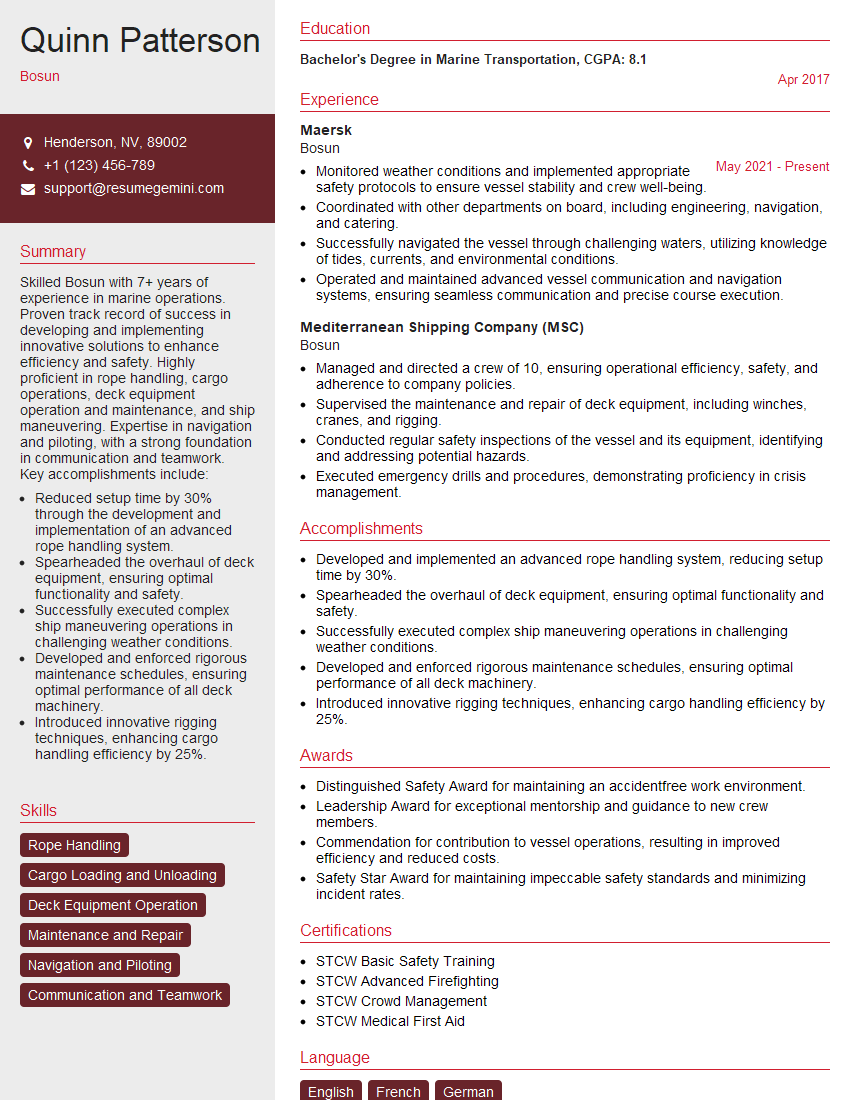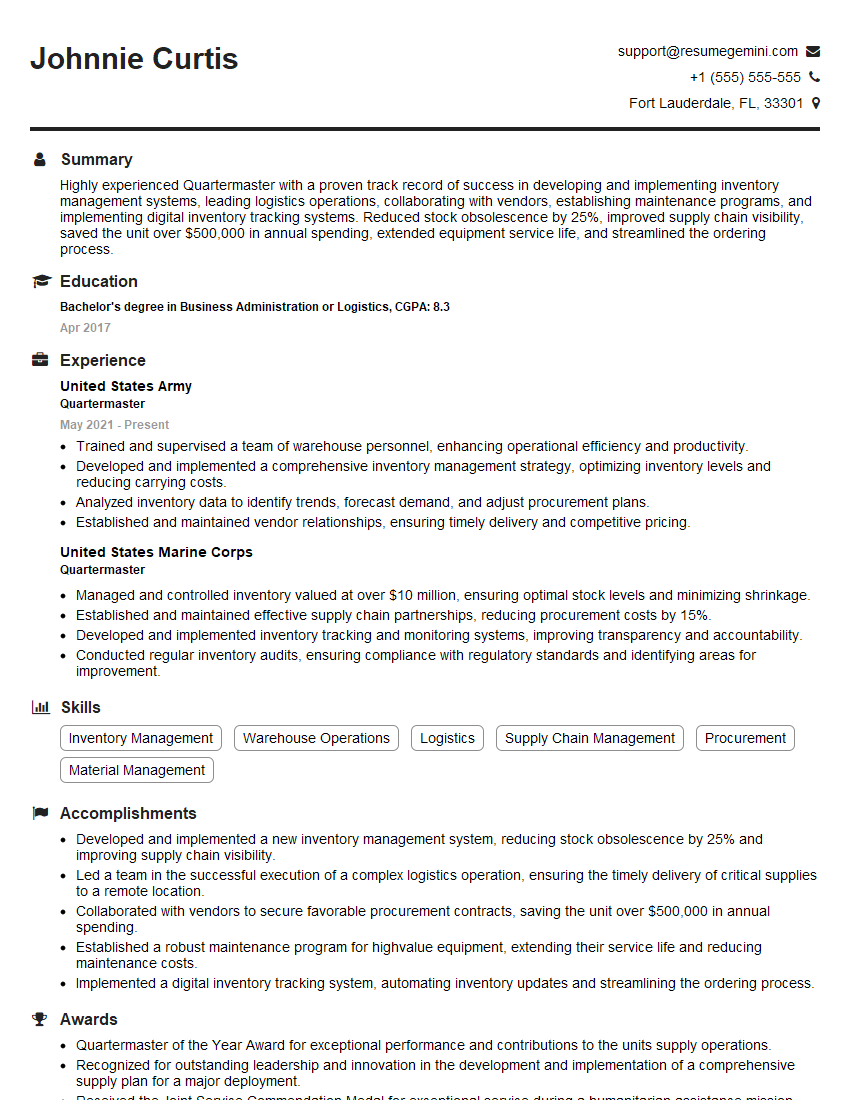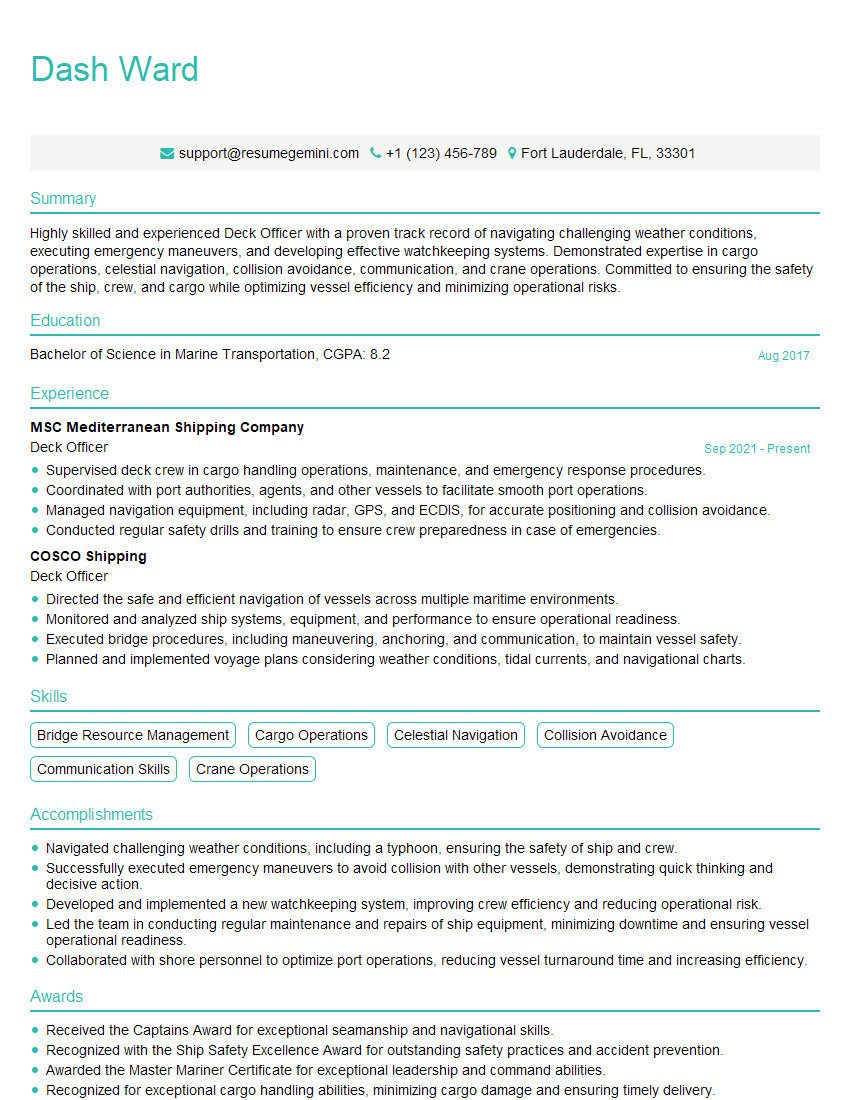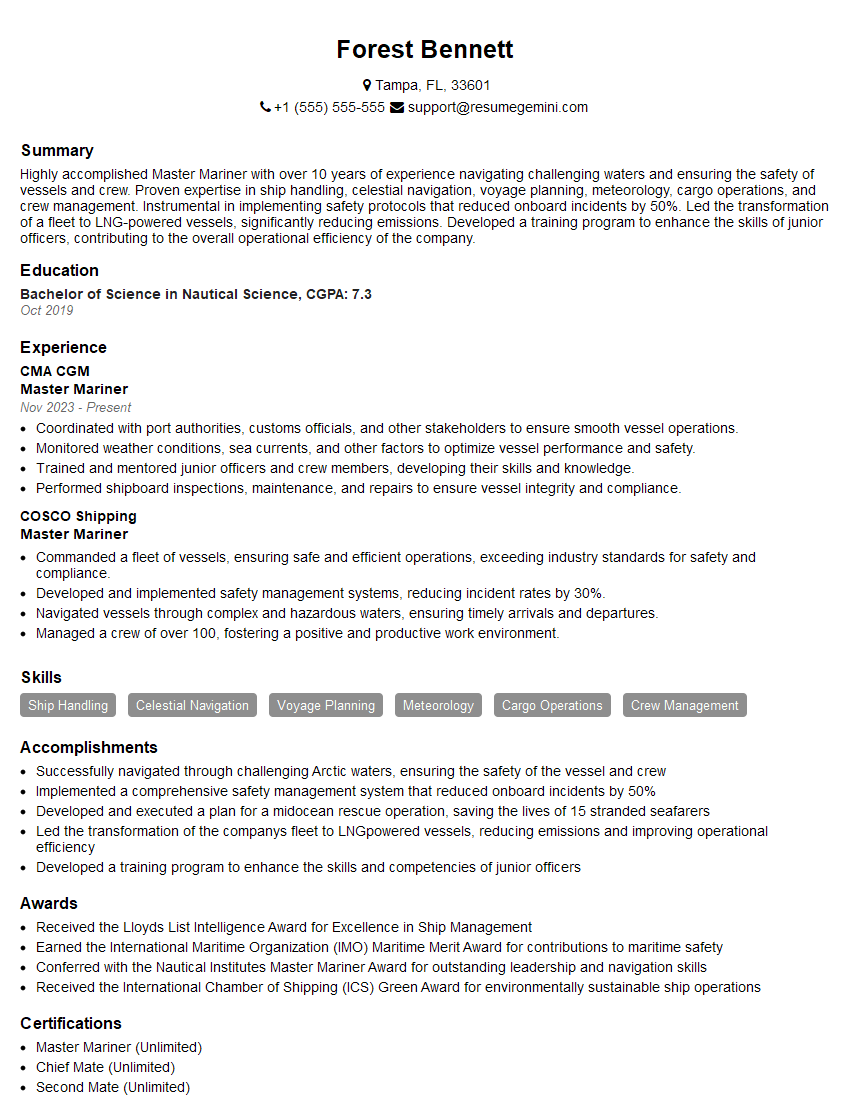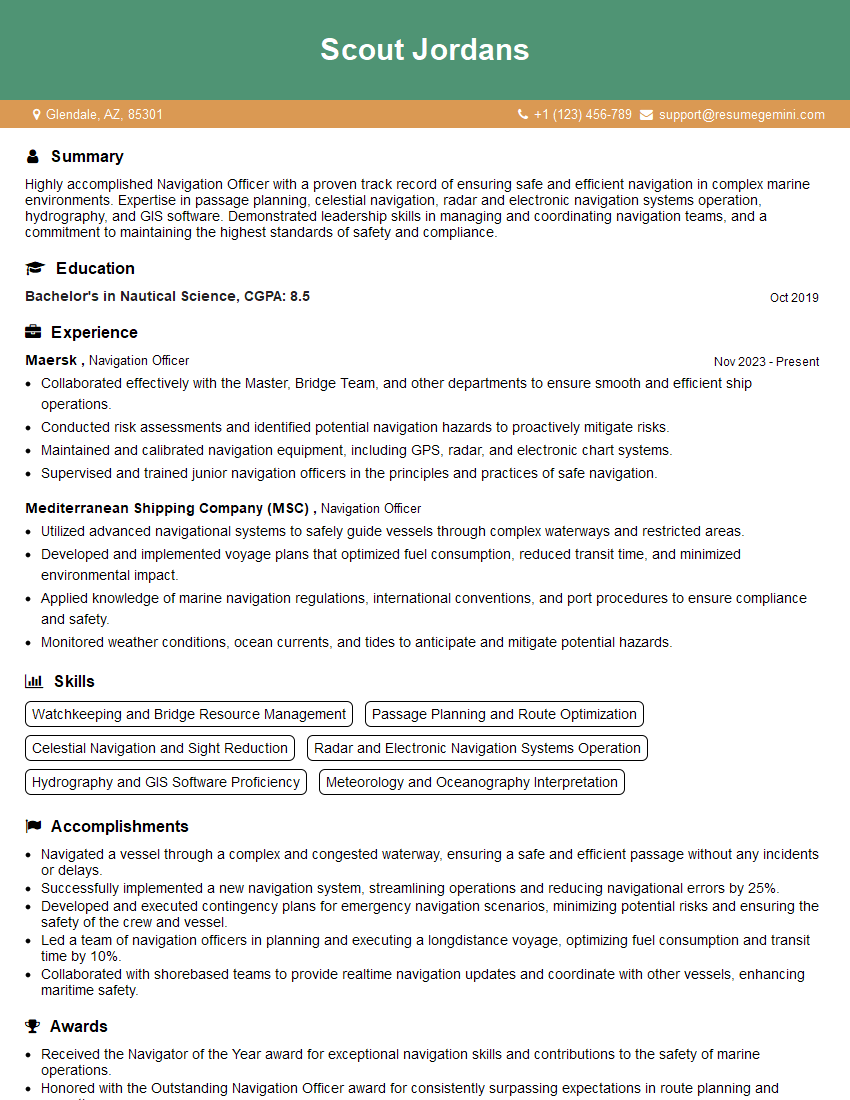The thought of an interview can be nerve-wracking, but the right preparation can make all the difference. Explore this comprehensive guide to Watchkeeping Duties interview questions and gain the confidence you need to showcase your abilities and secure the role.
Questions Asked in Watchkeeping Duties Interview
Q 1. Describe the standard watchkeeping procedures.
Standard watchkeeping procedures are a structured sequence of actions designed to ensure the safe navigation and operation of a vessel. They are based on established maritime practices and international regulations. A typical watch handover involves:
- Relief of Watch: The incoming watchkeeper arrives promptly and receives a thorough briefing from the outgoing watchkeeper. This includes information on the vessel’s position, course, speed, recent events (e.g., contacts, equipment malfunctions), and any pending tasks.
- Inspection of the Bridge and Equipment: The incoming watchkeeper thoroughly inspects the bridge, ensuring all navigation equipment (radar, GPS, AIS, etc.) is functioning correctly and calibrated. They check communication systems and emergency equipment.
- Reviewing the Logbook: The watchkeeper reviews the navigational logbook, noting any recent entries and ensuring continuity of recorded information.
- Maintaining Vigilance: Throughout the watch, the watchkeeper maintains constant vigilance, monitoring the vessel’s position, speed, and surrounding traffic using all available resources. This includes visually scanning the horizon, using radar and AIS to identify potential hazards, and listening to VHF radio communications.
- Recording Information in the Logbook: All significant events, including changes in course, speed, weather conditions, significant contacts, and equipment malfunctions, are meticulously recorded in the logbook. The time of each event should be precisely noted.
- Handover of Watch: Before the end of the watch, the outgoing watchkeeper is given a comprehensive briefing summarizing the watch period’s events, any outstanding issues, and the current vessel status.
These steps ensure a smooth and safe transition of responsibility, minimizing the risk of errors or incidents. Imagine it like a carefully orchestrated handover of responsibility in a hospital operating room – a methodical approach is crucial.
Q 2. Explain the importance of maintaining a proper watch log.
Maintaining a proper watch log is crucial for several reasons. It serves as a primary record of the vessel’s operation, providing legal evidence in case of incidents or disputes. It helps maintain safety by documenting significant events, allowing future analysis of trends or patterns. Consider it the ship’s memory. The logbook aids investigations, ensures accountability, and aids in continuous improvement of safety procedures.
- Legal Documentation: In the event of a collision, grounding, or other incident, the watch log serves as crucial legal evidence. Accurate records can significantly impact any subsequent investigations or legal proceedings.
- Safety Analysis: By reviewing the logbook, patterns can be identified, allowing the crew and management to understand potential risks and improve safety procedures. For example, a recurring issue with a specific piece of equipment can be addressed proactively.
- Accountability and Responsibility: The logbook establishes accountability for each watchkeeper’s actions and observations. This helps maintain a professional and responsible environment on board.
- Continuity of Operations: The logbook ensures that all crew members have access to relevant information about the vessel’s operations, providing a clear picture of the ship’s status and any recent events.
A well-maintained logbook is like a detective’s notebook; it holds the clues to understanding past events and helps prevent future problems.
Q 3. How do you handle emergencies during your watch?
Handling emergencies during a watch requires quick thinking, decisive action, and adherence to established procedures. The exact response will vary depending on the nature of the emergency, but a systematic approach is essential.
- Assess the Situation: Immediately assess the nature and severity of the emergency. What is happening? What is the immediate threat? How many people are involved?
- Alert the Master/Officer of the Watch: Immediately inform the Master or senior officer on watch. Clear and concise communication is vital.
- Implement Emergency Procedures: Follow established emergency procedures for the specific situation (e.g., man overboard, fire, collision). These procedures should be clearly defined in the ship’s safety management system.
- Take Immediate Action: Take any necessary immediate actions to mitigate the danger, such as issuing warnings, initiating damage control, or contacting emergency services. Don’t hesitate to make life-saving decisions within your authority.
- Document the Event: Make detailed log entries, describing the events, actions taken, and the outcome. Accurate records are vital for investigations and future improvement.
During an emergency, it’s akin to a firefighter responding to a blaze – rapid assessment, immediate action, and documented procedure are key. Calmness under pressure and effective communication are paramount.
Q 4. What are the key responsibilities of a watchkeeper?
The key responsibilities of a watchkeeper are multifaceted and crucial to the safe operation of a vessel. They include:
- Safe Navigation: Maintaining a safe course, speed, and lookout, avoiding collisions and other hazards.
- Monitoring Vessel Systems: Regularly monitoring and controlling the vessel’s systems, including engine room, navigation equipment, and communication systems.
- Maintaining Communications: Maintaining effective communications with other vessels, coast stations, and the bridge team.
- Maintaining Logbook: Accurately documenting all significant events, observations, and actions taken during the watch.
- Compliance with Regulations: Adhering to all relevant international and national regulations, including COLREGs and the STCW convention.
- Safety of Crew and Vessel: Ensuring the safety of all crew members and the vessel through vigilance and prompt response to any potential dangers.
- Weather Monitoring: Regularly monitoring weather conditions and making appropriate adjustments to the vessel’s operation as needed.
The watchkeeper is like a vigilant guardian, ensuring the safety and well-being of the ship and all aboard.
Q 5. Describe your experience with navigational equipment.
My experience with navigational equipment is extensive and encompasses a wide range of modern technologies. I am proficient in using:
- GPS (Global Positioning System): Determining the vessel’s precise location and tracking its movement.
- ECDIS (Electronic Chart Display and Information System): Utilizing electronic charts for navigation, planning routes, and managing voyage data.
- Radar: Detecting other vessels, landmasses, and navigational hazards, even in low visibility.
- AIS (Automatic Identification System): Receiving information about nearby vessels, including their identity, position, and course.
- Gyrocompass: Determining the vessel’s heading and maintaining a stable reference point.
- Auto Pilot: Using automated steering systems for maintaining a desired course and reducing workload.
- VHF Radio: Communicating with other vessels and coast stations for navigation and safety purposes.
I am also familiar with traditional navigational methods, such as using paper charts and taking celestial fixes, though these are less frequently used today. My skills ensure I can efficiently and safely navigate a vessel using a range of technologies.
Q 6. How do you ensure the safety of the vessel and crew during your watch?
Ensuring the safety of the vessel and crew during my watch involves a proactive and multi-layered approach. It begins with constant vigilance and extends to meticulous record-keeping.
- Constant Lookout: Maintaining a constant visual lookout for other vessels, navigational hazards, and potential dangers, utilizing binoculars and radar.
- Regular Checks: Regularly checking the vessel’s systems, including engines, steering gear, communications, and safety equipment.
- Weather Monitoring: Closely monitoring weather conditions and adapting navigation strategies as needed.
- Effective Communication: Maintaining clear and concise communication with other vessels, the bridge team, and coast stations.
- Following Procedures: Strict adherence to established safety procedures and emergency response protocols.
- Risk Assessment: Continuously assessing potential risks and taking proactive steps to mitigate them.
- Crew Welfare: Monitoring the well-being of the crew and ensuring they are aware of safety procedures.
My approach is proactive rather than reactive; anticipating problems and preventing them before they arise.
Q 7. Explain your understanding of COLREGs (International Regulations for Preventing Collisions at Sea).
COLREGs (International Regulations for Preventing Collisions at Sea) are a set of international maritime rules designed to prevent collisions between vessels. They establish rules of the road at sea, similar to traffic rules on land. Understanding and applying COLREGs is fundamental for safe navigation. Key aspects include:
- Rules of the Road: COLREGs define the responsibilities of vessels in various situations, such as meeting, crossing, overtaking, and navigating in restricted visibility.
- Lights and Shapes: Vessels are required to display specific lights and shapes at night and in reduced visibility to indicate their type and maneuverability.
- Sound Signals: Vessels use sound signals to warn other vessels of their presence and intentions.
- Action to Avoid Collision: COLREGs outline the actions that vessels should take to avoid a collision, emphasizing the importance of good seamanship and proper lookout.
- Restricted Visibility: Specific rules apply in situations with limited visibility, emphasizing the importance of reduced speed and increased vigilance.
Understanding COLREGs is essential, much like learning traffic laws for driving a car. A thorough grasp of these regulations ensures the safety of all vessels at sea. Failure to comply can lead to serious consequences, including collisions and legal ramifications.
Q 8. How do you manage fatigue during long watches?
Fatigue management during long watches is paramount for safe and effective watchkeeping. It’s not just about staying awake; it’s about maintaining optimal cognitive function and alertness. My strategy involves a multi-pronged approach:
Prioritizing Sleep: Adequate rest before a watch is crucial. I ensure I get sufficient, high-quality sleep in the days leading up to my watch. This means avoiding late nights and maintaining a regular sleep schedule as much as possible.
Hydration and Nutrition: Dehydration and poor nutrition significantly impact alertness. I maintain consistent hydration throughout my watch and eat regular, healthy meals, avoiding sugary snacks that lead to energy crashes.
Regular Breaks: Short, structured breaks are essential. Instead of relying on ‘micro-sleeps,’ I take planned 5-10 minute breaks to stretch, walk around, and clear my head, ensuring I am fresh and alert for the next period.
Environmental Control: A comfortable watchkeeping environment is crucial. This includes maintaining proper ventilation, temperature, and lighting to avoid drowsiness. I make sure the bridge is adequately lit and well-ventilated, avoiding extremes of temperature.
Cognitive Techniques: I actively engage in tasks to keep my mind alert. This involves regularly checking instruments, scanning the horizon, and conducting visual checks of the ship and its surroundings. Simple arithmetic or mental exercises during slower periods can also help prevent cognitive fatigue.
Reporting Fatigue: If I feel excessive fatigue despite these measures, I immediately report it to the officer-in-charge so appropriate action can be taken, such as a watch change.
During a long voyage, I meticulously follow the company’s fatigue management policy and participate in any training provided on managing fatigue and maintaining alertness at sea.
Q 9. What is your experience with using radar and AIS systems?
I have extensive experience using radar and AIS systems. My proficiency includes:
Radar Operation: I’m proficient in operating various types of radar, including X-band and S-band, understanding their limitations and capabilities. I can interpret radar echoes to identify targets (ships, land, weather), estimate range and bearing, and use various radar functions such as range-scaling, gain control, and sea clutter reduction to optimize performance. For example, I know how to distinguish between a true target and clutter by observing the stability and consistency of the echo on the screen.
AIS Utilization: I’m skilled in utilizing the Automatic Identification System (AIS) to track other vessels, identify their type, speed, course, and destination. I understand the limitations of AIS, such as its dependence on the vessel having its transponder operational and the potential for spoofing.
Integration of Radar and AIS: Crucially, I can effectively integrate radar and AIS data. For example, I can correlate radar targets with AIS information to positively identify vessels and assess potential collision risks. If a radar target is showing a collision course, and I cannot confirm its identity using AIS or other means, I take immediate action to avoid the potential collision.
During my time at sea, I’ve used radar and AIS in numerous situations, from routine navigation and traffic monitoring to emergency response, ensuring safe and efficient passage.
Q 10. How do you handle conflicts or disagreements with other crew members during your watch?
Conflicts are inevitable in any team environment, including watchkeeping. My approach is centered on professional communication and conflict resolution. I believe in:
Open and Respectful Dialogue: The first step is always open and respectful communication. I try to understand the other person’s perspective before reacting. I express my concerns calmly and clearly, focusing on the issue, not the person.
Active Listening: This involves truly listening to what the other person is saying, acknowledging their feelings and concerns, even if I don’t agree with them. Showing that I am listening actively diffuses tension.
Seeking Common Ground: I always try to find common ground and areas of agreement. Often, the initial perception of disagreement might stem from miscommunication or differing interpretations.
Seeking Mediation If Necessary: If the conflict cannot be resolved directly, I would involve the officer-in-charge to mediate the situation. This ensures a neutral party can help find a solution and prevent the situation from escalating.
For example, if there’s a disagreement about a navigational decision, I’d calmly explain my reasoning, listen to their perspective, and potentially refer to relevant charts, publications, or navigational rules to find common ground. The safety of the vessel is always the priority.
Q 11. Describe your experience with various types of charts and publications.
I am familiar with a wide range of nautical charts and publications, including:
Paper Charts: I’m proficient in using paper charts for navigation, including plotting positions, measuring distances, and understanding chart symbols and notations.
Electronic Charts (ENCs): I’m experienced with Electronic Chart Display and Information Systems (ECDIS), understanding their capabilities and limitations. I’m familiar with ENC updates and managing chart data to ensure accuracy.
Sailing Directions: I utilize sailing directions (pilots) for detailed information on coastal areas, including navigation hazards, harbor facilities, and local regulations.
Nautical Almanacs: I use nautical almanacs to determine celestial positions and perform celestial navigation calculations, although this is less common with modern GPS technology.
Tide Tables and Current Charts: I understand the importance of using tide tables and current charts to account for tidal effects on navigation and planning.
Notices to Mariners: I regularly check Notices to Mariners for updates on navigational hazards, chart corrections, and other important information affecting safe navigation.
My experience encompasses using these publications in various conditions, ranging from open ocean navigation to coastal pilotage. I’m adept at integrating information from multiple sources to create a comprehensive understanding of the navigational situation.
Q 12. How do you maintain situational awareness during your watch?
Maintaining situational awareness is the cornerstone of safe watchkeeping. It’s a continuous process requiring vigilance and proactive monitoring. My approach includes:
Systematic Scanning: I perform regular, systematic scans of the vessel’s surroundings, including radar, AIS, and visual observations. This ensures I detect potential hazards early.
Instrument Monitoring: I continuously monitor key instruments, including GPS, speed log, depth sounder, and compass, to track the vessel’s position, speed, and heading. I also monitor weather reports and forecasts, understanding their impact on navigation.
Traffic Monitoring: I pay close attention to other vessels in the vicinity, assessing their course, speed, and potential for collision. I use AIS and radar to track vessel movements and avoid potential conflicts.
Communication and Collaboration: I maintain clear communication with the bridge team, and other crew members, and with other vessels, as needed, to share relevant information and ensure collective situational awareness.
Proactive Risk Assessment: I conduct regular risk assessments to anticipate potential hazards and take preventative measures. This includes considering factors such as weather conditions, traffic density, and the vessel’s capabilities.
Maintaining situational awareness isn’t passive; it’s an active, continuous process requiring constant engagement and critical thinking.
Q 13. Explain your understanding of GMDSS (Global Maritime Distress Safety System).
The Global Maritime Distress Safety System (GMDSS) is a globally standardized system for maritime distress alerting, communication, and search and rescue (SAR). It uses a variety of communication technologies to ensure distress calls can be transmitted and received, regardless of location. My understanding includes:
Distress Alerting: I’m familiar with various methods of sending distress alerts, including EPIRB (Emergency Position-Indicating Radio Beacon), Inmarsat-C, and VHF radio. I understand the procedures for initiating a distress alert and providing crucial information, such as the vessel’s position, nature of the distress, and number of people on board.
Communication Channels: I understand the different communication channels within GMDSS, including VHF, MF/HF radio, and satellite communication systems. I know how to utilize each channel effectively, based on the situation.
Search and Rescue (SAR): I understand how GMDSS integrates with SAR operations, ensuring effective communication between the distressed vessel and the rescue services.
Safety Procedures: I’m familiar with the GMDSS safety procedures and protocols, including the use of the distress signal (Mayday), urgency signal (Pan Pan), and safety signal (Securité).
GMDSS is crucial for maritime safety, and my knowledge is essential for responding effectively to emergencies and ensuring the safety of life at sea.
Q 14. How do you handle communication with other vessels and shore stations?
Communication with other vessels and shore stations is critical for safe and efficient navigation. My experience covers various methods:
VHF Radio: I am proficient in using VHF radio for short-range communication, adhering to established radio procedures and protocols (e.g., using proper call signs and distress signals).
MF/HF Radio: I am familiar with MF/HF radio for long-range communication, utilizing various communication modes, including voice, telex, and data transmission. I understand the complexities of propagation and signal strength at longer ranges.
Inmarsat-C: I can utilize satellite communication systems, such as Inmarsat-C, for reliable communication, especially in remote areas beyond the range of VHF and MF/HF radio.
AIS: Although not primarily a communication system, AIS provides important information about other vessels that forms the basis for safe navigation and improves communication coordination. I use the AIS to establish and maintain awareness of surrounding vessels and relay information during navigational events.
GMDSS Procedures: I’m experienced in using all communication methods within the GMDSS framework to transmit distress calls and other important messages in emergency situations.
Effective communication involves clear, concise messages, proper radio etiquette, and an understanding of the limitations of each communication system. I always prioritize safe and efficient communication practices.
Q 15. Describe your experience with various types of navigational aids.
Throughout my career, I’ve extensively utilized a wide array of navigational aids, ranging from traditional methods to the most advanced modern technology. My experience encompasses the use of:
- Traditional Methods: Paper charts, parallel rules, dividers, and plotting techniques. I’m proficient in using these methods for backup and to enhance situational awareness, even when relying on electronic systems.
- Electronic Chart Display and Information Systems (ECDIS): I’m highly experienced with ECDIS, proficient in chart updates, route planning, and utilizing its various safety features like anti-collision alarms and route monitoring.
- Global Navigation Satellite Systems (GNSS): I’m well-versed in using GPS, GLONASS, and Galileo systems for precise positioning, understanding their limitations and potential errors like multipath interference. I know how to cross-check GNSS data with other navigational aids to ensure accuracy.
- Radar: I’m skilled in interpreting radar returns to identify targets, determine range and bearing, and understand the limitations of radar in various weather conditions. This includes using ARPA (Automatic Radar Plotting Aid) for collision avoidance.
- Automatic Identification System (AIS): I’m proficient in utilizing AIS for identifying nearby vessels, monitoring their course and speed, and enhancing collision avoidance. I understand its limitations, knowing that not all vessels transmit AIS signals.
- Gyrocompass and Magnetic Compass: I understand the principles of operation for both and can identify and compensate for their errors. I know when one system might be more reliable than the other.
For instance, during a recent voyage through a heavily trafficked area, a temporary GNSS outage occurred. My experience with traditional methods allowed me to seamlessly switch to paper charts and maintain a safe and accurate course until GNSS service was restored. This demonstrated the importance of a holistic approach to navigation, integrating both traditional and modern tools.
Career Expert Tips:
- Ace those interviews! Prepare effectively by reviewing the Top 50 Most Common Interview Questions on ResumeGemini.
- Navigate your job search with confidence! Explore a wide range of Career Tips on ResumeGemini. Learn about common challenges and recommendations to overcome them.
- Craft the perfect resume! Master the Art of Resume Writing with ResumeGemini’s guide. Showcase your unique qualifications and achievements effectively.
- Don’t miss out on holiday savings! Build your dream resume with ResumeGemini’s ATS optimized templates.
Q 16. How do you conduct a proper lookout?
Conducting a proper lookout is paramount for safety at sea. It’s more than just passively observing; it’s an active and systematic process. I ensure a proper lookout by following these steps:
- Designated Lookout: A designated individual, or preferably two, is always assigned lookout duty, especially during reduced visibility or in congested waters.
- Systematic Scan: The lookout employs a systematic scan, covering the entire horizon, from bow to stern, using binoculars for distant objects. They should utilize a regular pattern to avoid missing anything.
- Reporting: The lookout promptly reports all relevant information to the Officer of the Watch (OOW), including but not limited to: other vessels, navigational hazards, changes in weather, and any unusual occurrences. Reports are clear, concise, and include range, bearing, and estimated speed.
- Awareness of Limitations: The lookout understands their own limitations—distance, visibility, and potential for fatigue. Regular shifts are vital for maintaining alertness.
- Night Vision: During night-time operations, the lookout utilizes appropriate night vision equipment and understands its effectiveness and limitations.
- Communication: Clear and consistent communication is maintained between the lookout and the OOW to ensure that any potential threats are identified and dealt with promptly.
Imagine a situation where fog suddenly rolls in. A diligent lookout, systematically scanning, might spot a vessel emerging from the fog at a critical distance. Their timely report allows the OOW to take evasive action, potentially avoiding a collision.
Q 17. Explain your experience with bridge resource management.
Bridge Resource Management (BRM) is a crucial element of safe and efficient navigation. It’s a team-based approach that emphasizes effective communication, collaboration, and leadership to optimize decision-making. My experience with BRM includes:
- Effective Communication: I actively participate in clear, concise, and unambiguous communication with all bridge team members, ensuring everyone is aware of the situation and their role.
- Situational Awareness: I consistently strive to maintain a comprehensive understanding of the vessel’s position, course, speed, surrounding traffic, and weather conditions. I use all available resources for this.
- Problem Solving: When challenges arise, I contribute to collaborative problem-solving, ensuring all perspectives are considered and the best course of action is selected. I actively encourage input from others.
- Workload Management: I am skilled in managing workload effectively, assigning tasks appropriately, and ensuring all tasks are completed accurately and safely.
- Decision Making: I am comfortable making informed decisions, considering all available data and seeking advice when necessary. I understand the consequences of hasty decisions.
- Teamwork and Leadership: I foster a positive team environment and actively participate in the effective delegation and supervision of tasks.
For example, during a challenging docking maneuver in strong currents, effective BRM ensured that all team members understood their roles – the helmsman for steering, the lookout for external observations, and myself as the OOW for coordinating and decision-making. This teamwork led to a smooth and safe docking.
Q 18. How do you perform a passage plan?
A passage plan is a crucial document outlining the intended route, anticipated hazards, and contingency plans for a voyage. Creating one involves several stages:
- Obtain Information: Gather all relevant navigational information, including charts, weather forecasts, Notices to Mariners, and publications.
- Plan the Route: Using ECDIS or paper charts, plot the most efficient and safe route, considering factors like traffic density, water depth, and navigational hazards.
- Consider Hazards: Identify potential hazards along the planned route, such as shallow water, restricted areas, ice, or other vessels.
- Determine Waypoints: Establish waypoints along the route to aid in navigation and monitoring progress. This will help ensure adherence to the plan.
- Calculate ETA: Calculate the estimated time of arrival (ETA) at key points along the route, considering speed, current, and other factors.
- Develop Contingencies: Plan for contingencies, such as equipment failure, adverse weather, or other unforeseen circumstances. This could involve alternate routes or safe havens.
- Document the Plan: Clearly document the entire passage plan, including the route, waypoints, ETA, and contingency plans, for review and approval by the Master.
- Monitor and Adjust: Throughout the voyage, continuously monitor the passage plan, making adjustments as needed based on changing conditions.
A well-executed passage plan is like a roadmap for a journey, guiding the vessel safely to its destination. During a passage in heavy seas, having a carefully prepared passage plan with well-defined contingencies allows for rapid adaptation to changing circumstances, thus maintaining safety.
Q 19. Describe your experience with emergency procedures, such as man overboard.
I have extensive experience with various emergency procedures, particularly man overboard (MOB) drills and actual responses. My training and experience ensure a prompt and efficient response:
- Immediate Actions: Upon observing a person overboard, I immediately initiate the MOB drill. This includes activating the MOB alarm and directing the helmsman to put the vessel into a safe maneuver.
- Locate the Person: We immediately locate the person using the lifebuoy’s marker light and other visual and electronic aids, including radar and AIS if available. This is critical in low-light or rough sea conditions.
- Deploy Equipment: We deploy the lifebuoy with its light and rescue equipment as quickly as possible. Recovery equipment is ready to be deployed.
- Recovery Procedures: I am proficient in various recovery techniques, including using the rescue boat, and understand the use of appropriate rescue equipment like life rings and throw lines.
- Post-Rescue Procedures: Following the successful rescue, I ensure that all safety procedures and the post-incident procedures are followed. This includes checking all equipment, documenting everything for reporting purposes.
- Crew Training: I have played a crucial role in training the crew in emergency response protocols, emphasizing the importance of quick actions and effective teamwork.
During a training exercise, we simulated a nighttime MOB situation. The effective execution of the plan, including the immediate activation of the MOB alarm, the use of the boat, and the accurate use of searchlights resulted in a successful simulated rescue in under ten minutes.
Q 20. Explain your understanding of the ship’s safety management system.
A Ship’s Safety Management System (SMS) is a comprehensive framework designed to proactively prevent accidents and incidents. My understanding encompasses:
- Safety Policy: A clearly defined safety policy establishes the company’s commitment to safety and sets the overall direction for the SMS. I ensure that I understand and follow the ship’s safety policy.
- Risk Assessment: Regular risk assessments are conducted to identify potential hazards and implement measures to mitigate them. I actively participate in these assessments.
- Safety Procedures: Standard operating procedures (SOPs) are developed for various tasks and emergencies to maintain a consistent approach to safety. I ensure that all crew members follow the SOPs correctly.
- Emergency Response Plans: Comprehensive emergency response plans are in place for various scenarios, including fire, flooding, and medical emergencies. I know and regularly practice all of them.
- Safety Training: Regular safety training is provided to crew members to maintain their competence and awareness of safety procedures. I am actively involved in participating and reinforcing safety training.
- Audits and Inspections: Regular audits and inspections ensure that the SMS remains effective and meets regulatory requirements. I understand the importance of following all safety regulations and reporting any concerns.
- Reporting and Investigation: A well-defined reporting and investigation system allows for identifying causes of incidents and implementing corrective actions. I ensure that I use the correct procedures for reporting and recording any incidents and near-misses.
For example, our ship’s SMS includes a detailed procedure for managing oil spills, encompassing steps from initial detection to cleanup and reporting to authorities. This preparedness ensures a quick and effective response to minimize environmental damage.
Q 21. How do you respond to various weather conditions?
Responding to various weather conditions requires a proactive and adaptable approach. My experience includes:
- Monitoring Weather Forecasts: I regularly monitor weather forecasts and warnings from meteorological services to anticipate changing conditions and plan accordingly.
- Adjusting Course and Speed: I adjust the vessel’s course and speed to minimize the impact of adverse weather, such as strong winds, heavy seas, or reduced visibility.
- Securing the Vessel: I implement measures to secure the vessel against harsh weather, including securing loose items on deck, closing watertight doors, and reducing speed to prevent damage.
- Navigational Strategies: I adapt my navigation strategies based on the weather conditions. For instance, using radar and AIS becomes more critical in reduced visibility.
- Communication: I maintain effective communication with the bridge team and shore-based authorities to keep everyone informed and coordinate actions.
- Seeking Shelter: If necessary, I seek shelter in a safe haven or port to avoid the worst of the storm.
During a recent passage through a tropical storm, we adjusted our course to avoid the strongest winds and seas, while the crew implemented measures to secure the vessel, minimizing the risks. This showed the importance of preparation and adaptability.
Q 22. How do you handle equipment malfunctions during your watch?
Equipment malfunctions during watchkeeping are a serious concern, demanding immediate and appropriate action. My approach is guided by a systematic process focused on safety and efficient problem-solving.
Immediate Assessment: First, I’d identify the nature and extent of the malfunction. Is it a critical system like the GPS or a less crucial element like the coffee machine? The urgency of my response depends directly on the impact on safety and navigation.
Safety First: If the malfunction affects navigation or safety (e.g., radar failure in fog), I would immediately inform the Master or Officer of the Watch, taking appropriate mitigating actions such as reducing speed or altering course depending on the situation. This might involve switching to backup systems or reverting to traditional methods. I always prioritize the safety of the vessel, crew, and environment.
Troubleshooting and Reporting: I’d attempt basic troubleshooting steps according to the equipment’s operating manual, documenting all actions taken. This is critical for subsequent repairs and incident reporting. If I’m unable to resolve the issue, I’d immediately report it to the appropriate personnel (Chief Engineer for engine room issues, etc.) and continue to monitor the situation, using alternative methods where possible.
Documentation: Meticulous record-keeping is paramount. I’d log the malfunction, time of occurrence, actions taken, and any relevant observations in the ship’s logbook. This is crucial for investigation, analysis, and preventative maintenance planning.
For instance, during a night watch, I once experienced a failure in the autopilot. Following the steps above, I immediately switched to manual steering, informed the Master, documented the event in the logbook, and contacted the Chief Engineer to assess the situation. Fortunately, we had a redundant steering system, so navigation was not severely impacted.
Q 23. Describe your experience with cargo operations and safety.
My experience with cargo operations emphasizes safety at every stage. I’ve been involved in various types of cargo handling, from containers to bulk goods, always adhering to the highest safety standards. My responsibilities included monitoring loading and discharging operations, ensuring adherence to safety procedures, and checking securing arrangements.
Pre-Loading Checks: Before loading commences, I’d verify the cargo plan, ensuring it aligns with the vessel’s stability and structural limitations. This would include checks of stowage plans, securing arrangements, and compliance with relevant international regulations.
During Loading/Discharging: Constant monitoring of loading/discharging operations is crucial to identify any potential hazards. I would observe crane operations, securing of cargo, and the condition of the cargo itself. I’d also ensure compliance with safety regulations and emergency response plans.
Post-Loading Checks: After completion of cargo operations, I would verify that the cargo is secured properly and that the vessel is stable and seaworthy. This includes checking lashings, securing devices, and confirming that all cargo documentation is in order.
Communication: Effective communication with the cargo officers, crane operators, and the bridge is paramount to prevent accidents. Clear instructions and prompt responses to any issues are vital.
For example, I once observed a slight list during container loading. By promptly informing the cargo officer and the Master, we were able to rectify the problem before it escalated into a more serious issue. The quick action prevented delays and ensured safety.
Q 24. What are the limitations of using electronic charts?
Electronic charts (ECDIS) are invaluable navigational tools, but they have limitations. It’s crucial to understand these limitations to avoid misinterpretations and potential navigational errors.
Data Dependency: ECDIS relies on accurate and up-to-date chart data. Outdated or incomplete data can lead to significant errors in position, depth information, and other critical navigational parameters. Regular updates are essential.
System Failure: ECDIS, like any electronic device, can malfunction. Having backup systems and navigational skills is crucial in case of system failure. A complete reliance on ECDIS without proper backup is risky.
Human Error: Improper use or misinterpretation of ECDIS data can lead to errors. Users must possess strong navigational skills and understand the limitations of the system. Over-reliance on automation can lead to complacency.
Limited Information: ECDIS might not display all relevant information, such as local notices to mariners or specific details about a particular harbor. Cross-referencing with paper charts and other navigational sources is necessary.
Visual Limitations: The screen size can limit the displayed area; therefore, seafarers must be aware of the extent of the displayed area and ensure continuous monitoring.
For example, an inaccurate chart update can lead to incorrect depth information, potentially causing grounding. Therefore, maintaining awareness of the system’s limitations and employing supplementary navigational practices is crucial.
Q 25. How do you ensure proper communication with the bridge during a watch?
Maintaining effective communication with the bridge is essential for safe and efficient watchkeeping. This involves a combination of formal reporting procedures and proactive communication.
Regular Reporting: I adhere to established reporting procedures, providing regular updates on the vessel’s position, course, speed, and any significant events or observations. This might be done verbally or through a dedicated communication system.
Proactive Communication: I wouldn’t hesitate to contact the bridge immediately if I observe anything unusual or potentially hazardous, such as changes in weather, approaching vessels, or equipment malfunctions. Prompt reporting prevents potential incidents.
Clear and Concise Language: Communication should be clear, concise, and unambiguous, avoiding jargon where possible. The use of standardized terminology and phrases ensures consistent understanding.
Confirmation of Messages: Always ensure that messages are correctly understood by confirming their reception. This helps to avoid misunderstandings and ensures the safety of the vessel.
For instance, if I detect a change in wind speed and direction which might affect our course, I will immediately inform the Officer of the Watch on the bridge, providing specific details such as the direction and speed of the wind. This proactive communication allows for timely adjustments and avoids potential issues.
Q 26. How do you maintain a safe working environment during your watch?
Maintaining a safe working environment during my watch is a top priority. My approach is multifaceted and considers both the immediate surroundings and the broader operational context.
Housekeeping: I ensure the watch station and surrounding areas are clean, tidy, and free of hazards. This includes securing loose items, ensuring clear passageways, and checking for potential trip hazards.
Equipment Checks: Regular checks of all equipment are carried out to ensure its proper functioning and safety. This includes navigational equipment, communication systems, and safety devices.
Personal Protective Equipment (PPE): I always use appropriate PPE when necessary, such as life jackets, safety boots, and eye protection.
Emergency Procedures: Familiarization with and adherence to emergency procedures is essential. This includes fire-fighting procedures, man overboard drills, and other relevant protocols.
Risk Assessment: I conduct ongoing risk assessment, identifying potential hazards and implementing measures to mitigate them. This might include adapting procedures based on weather conditions or other factors.
For example, during a night watch in rough seas, I ensured that all loose items on the bridge were secured to prevent them from becoming projectiles. This simple action contributed significantly to a safe working environment.
Q 27. Explain your knowledge of the International Code of Signals.
The International Code of Signals (ICS) is a crucial tool for communication at sea. My knowledge of the ICS covers both its visual and sound signals. It provides a standardized system for conveying essential information between vessels and between vessels and shore stations.
Visual Signals: I am proficient in using flags, shapes, and lights to communicate various messages, including distress signals, requests for assistance, and navigational information. This includes understanding the flag alphabets and their combinations to create meaningful messages.
Sound Signals: I’m familiar with the various sound signals used for conveying warnings, intentions, and other crucial information. This knowledge is particularly important during reduced visibility.
Understanding Messages: Besides sending messages, it’s crucial to understand messages from other vessels or shore stations. This requires thorough knowledge of the ICS codebook and the ability to interpret signals accurately.
Emergency Signals: I’m particularly adept at recognizing and responding to distress signals, ensuring prompt action is taken to assist vessels in distress.
For example, understanding the meaning of a ‘Mayday’ call or recognizing the distress flags are critical for responding efficiently to emergencies. The ICS provides a common language for maritime safety.
Q 28. Describe your experience with maintaining navigational equipment.
Maintaining navigational equipment is critical for safe and efficient navigation. My experience encompasses both routine maintenance and troubleshooting.
Routine Checks: I perform regular checks of navigational equipment, including the GPS, radar, gyrocompass, and other systems. This includes verifying their proper functioning and calibration.
Calibration: I have experience calibrating certain instruments and understand the importance of regular calibration to maintain accuracy.
Troubleshooting: I’m capable of basic troubleshooting of common equipment malfunctions. This involves identifying the problem, attempting to rectify it, and reporting the issue to the relevant personnel if necessary.
Record Keeping: I meticulously document all maintenance activities and any equipment malfunctions in the ship’s logbook. This provides a valuable record for tracking performance and scheduling future maintenance.
Understanding limitations: I am aware of the limitations of every piece of equipment and how those limitations might impact navigation. This includes backup systems and alternatives when a specific piece of equipment fails.
For example, I’ve conducted routine checks on the radar, ensuring its proper functioning and accuracy. I’ve also participated in troubleshooting exercises, gaining valuable experience in identifying and resolving equipment issues.
Key Topics to Learn for Watchkeeping Duties Interview
- Navigation and Chartwork: Understanding chart symbols, plotting courses, using electronic charting systems (ECDIS), and calculating estimated time of arrival (ETA).
- Collision Avoidance: Applying COLREGs (International Regulations for Preventing Collisions at Sea), understanding radar interpretation, and practicing effective lookout procedures.
- Cargo Operations: Familiarizing yourself with safe cargo handling practices, relevant regulations (SOLAS), and procedures for different cargo types.
- Emergency Procedures: Knowledge of emergency response plans, fire-fighting techniques, and man overboard procedures. Practical application of drills and simulations is crucial.
- Communication Skills: Proficiency in using VHF radio, GMDSS (Global Maritime Distress and Safety System), and other communication systems. Practicing clear and concise communication is essential.
- Ship Security: Understanding the International Ship and Port Facility Security (ISPS) Code and implementing security measures onboard.
- Maintenance and Repair: Basic understanding of ship systems, troubleshooting minor issues, and reporting maintenance requirements. This includes familiarity with preventative maintenance schedules.
- Meteorology and Oceanography: Interpreting weather forecasts, understanding tidal currents, and applying this knowledge to safe navigation.
- Bridge Resource Management (BRM): Understanding teamwork, communication, and leadership skills in a bridge environment. Demonstrating proficiency in effective decision-making under pressure.
- Logbook Maintenance: Proper documentation of all relevant events and activities during watchkeeping, ensuring accuracy and completeness.
Next Steps
Mastering Watchkeeping Duties is paramount for career advancement in the maritime industry, opening doors to higher-level positions and increased responsibility. A well-crafted resume is crucial for showcasing your skills and experience to potential employers. To maximize your job prospects, create an ATS-friendly resume that highlights your key accomplishments and qualifications. We recommend using ResumeGemini, a trusted resource for building professional resumes, to ensure your application stands out. Examples of resumes tailored to Watchkeeping Duties are available to help guide you through this process.
Explore more articles
Users Rating of Our Blogs
Share Your Experience
We value your feedback! Please rate our content and share your thoughts (optional).
What Readers Say About Our Blog
Hi, I have something for you and recorded a quick Loom video to show the kind of value I can bring to you.
Even if we don’t work together, I’m confident you’ll take away something valuable and learn a few new ideas.
Here’s the link: https://bit.ly/loom-video-daniel
Would love your thoughts after watching!
– Daniel
This was kind of a unique content I found around the specialized skills. Very helpful questions and good detailed answers.
Very Helpful blog, thank you Interviewgemini team.
